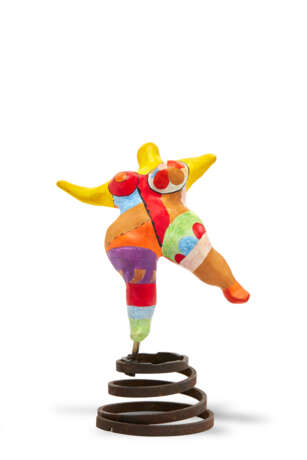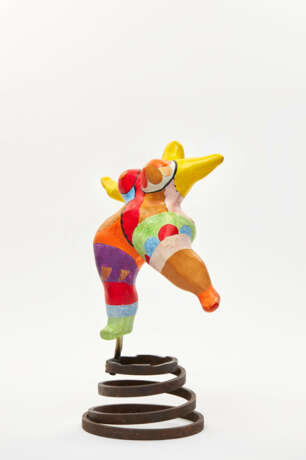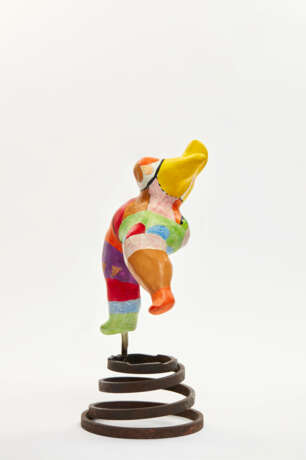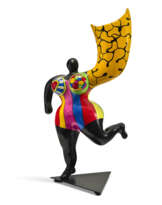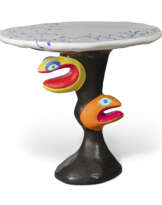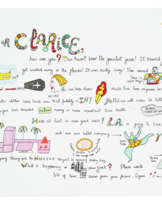ID 832053
Лот 38 | Niki de Saint Phalle (1930-2002)
Оценочная стоимость
€ 50 000 – 70 000
Mini Nana
acrylique sur polyester et métal
42 x 28.6 x 16.5 cm.
Exécutée vers 1970, cette œuvre est unique
acrylic on polyester and metal
16 1/2 x 11 1/4 x 6 1/2 in.
Executed circa 1970, this work is unique
Provenance
Alexina Duchamp, France.
Puis par descendance au propriétaire actuel.
Special notice
Artist's Resale Right ("droit de Suite").
If the Artist's Resale Right Regulations 2006 apply to this lot, the buyer also agrees to pay us an amount equal to the resale royalty provided for in those Regulations, and we undertake to the buyer to pay such amount to the artist's collection agent.
ƒ: In addition to the regular Buyer’s premium, a commission of 5.5%
inclusive of VAT of the hammer price will be charged to the buyer.
It will be refunded to the Buyer upon proof of export of the lot
outside the European Union within the legal time limit.
(Please refer to section VAT refunds)
Post lot text
« Je n’ai pas fait mes artistes, mes artistes m’ont fait ». - Pierre Matisse
“I did not make my artists, my artists made me.” - Pierre Matisse
Offertes par un membre de la famille d’Henri Matisse, ces œuvres faisaient auparavant partie de la collection du légendaire marchand d’art et fils cadet de l’artiste, Pierre Matisse. Considérées dans leur ensemble, elles offrent un aperçu fascinant du monde interconnecté de l’art de l’après-guerre, leurs histoires révélant les amitiés, dialogues et rivalités artistiques, les liens familiaux et les amours caractéristiques de cette période.
Pierre Matisse arrive à New York en 1924 et souhaite s’établir comme marchand d’art. En novembre 1931, il ouvre sa galerie éponyme dans le Fuller Building au 41 East 57th Street, qui devient rapidement un centre d’art européen et contemporain. Au cours des décennies suivantes, Matisse s’avèrera l’un des marchands les plus influents du pays, surmontant avec succès les turbulences causées par la Grande Dépression et la deuxième Guerre mondiale.
Dans sa galerie, il ne se contente pas d’exposer les œuvres des maîtres européens établis, mais fait découvrir au public américain un certain nombre d’artistes plus jeunes : il est le premier à exposer les œuvres de Jean Dubuffet, Alberto Giacometti et Joan Miró. Dans de nombreux cas, Matisse est responsable de la création d’un marché pour ces artistes dans son pays d’adoption. La deuxième Guerre mondiale voit une foule d’artistes européens arriver à New York, dont André Breton, Yves Tanguy, Max Ernst, Roberto Matta, Piet Mondrian, Marc Chagall, parmi beaucoup d’autres. Avec sa femme Alexina Sattler, « Teeny » comme on l’appelle, Matisse est une figure centrale de ce nouveau monde de l’art qui se développe dans la ville, en soutenant de nombreux artistes se retrouvant déracinés. En mars 1942, il organise une exposition collective, « Artistes en exil », événement marquant qui présente les œuvres de quatorze de ces artistes.
La relation de Matisse avec Jean Dubuffet commence en 1946. Alors relativement inconnu, il présente sa première exposition à la galerie Pierre Matisse en 1947. Bien accueillie par la critique, elle marque également le début de l’engouement des collectionneurs américains pour son œuvre. Matisse restera le marchand de Dubuffet jusqu’en 1960.
L’exposition Giacometti de Matisse en 1948 a fait date et grande impression. Deux ans auparavant, une commande a ravivé l’intérêt de Matisse pour l’œuvre de Giacometti et les deux hommes commencent à correspondre régulièrement entre Paris et New York. L’exposition est la première à montrer la dernière évolution du style sculptural de Giacometti et, avec l’introduction de Jean-Paul Sartre dans le catalogue, cette exposition devient un moment clé dans l’histoire de l’avant-garde d’après-guerre.
Le programme d’exposition novateur de Matisse devient légendaire, et inclut des artistes tels qu’Alexander Calder, Leonora Carrington, Jean-Paul Riopelle et Zao Wou Ki. Plus qu’un simple marchand, Matisse noue des amitiés étroites avec nombre de ces artistes. « Je n’ai pas "fait" mes artistes. Mes artistes m’ont fait », déclare-t-il un jour (cité dans J. Russell, Matisse: Father and Son, New York, 1999, p. 273). Lorsque Jean-Pierre Riopelle traverse une période difficile, Matisse achète tout ce qui se trouve dans son atelier, en lui disant : « Si tu tombes, je tombe avec toi ! » (cité dans ibid., p. 297).
Représentant la convergence d’un marchand d’art influent et de son écurie d’artistes, ces lots sont autant de rappels poignants du riche héritage et des dialogues passionnants entre ces artistes et ces familles tout au long du vingtième siècle.
Offered from a member of the Matisse family, these works were formerly in the collection of the legendary art dealer and younger son of the artist, Henri, Pierre Matisse. Regarded together, they provide a fascinating glimpse into the interconnected world of art in the post-war era, their histories revealing the artistic friendships, dialogues and rivalries, family ties and love affairs that define this period.
In Matisse’s gallery, he not only showed art by established European masters, but introduced a number of younger artists to American audiences, becoming the first to exhibit the work of Jean Dubuffet, Alberto Giacometti, and Joan Miró. In many cases, Matisse was responsible for building a market for these artists in his adopted country. The Second World War saw a host of European artists arrive in New York, including André Breton, Yves Tanguy, Max Ernst, Roberto Matta, Piet Mondrian, Marc Chagall, among many others. Together with his wife, Alexina Sattler, “Teeny” as she was known, Matisse was a central figure in this new art world that developed in the city, supporting many of the artists who had found themselves uprooted. In March 1942, he held a group show, “Artists in Exile,” a landmark event which featured the work of fourteen of these artists.
Matisse’s relationship with Jean Dubuffet began in 1946. Then a relatively unknown artist, he had his first show at the Pierre Matisse Gallery in 1947. Well received by critics, it also marked the start of a desire for his work by American collectors. Matisse would remain Dubuffet’s dealer until 1960.
Matisse’s 1948 Giacometti exhibition was seminal and caused a sensation. Two years prior, a commission had reignited Matisse’s interest in Giacometti’s work as the pair began to correspond regularly between Paris and New York. The exhibition was the first to show Giacometti’s latest leap in sculptural style, and, together with Jean-Paul Sartre’s introduction in the catalogue, this show became a landmark moment in the story of the post-war avant-garde.
Matisse’s innovative exhibition program became legendary, including artists such as Alexander Calder, Leonora Carrington, Jean-Paul Riopelle, and Zao Wou Ki. More than solely a dealer, Matisse forged close friendships with many of these artists. “I did not ‘make’ my artists. My artists made me,” he once said (quoted in J. Russell, Matisse: Father and Son, New York, 1999, p. 273). When Jean-Pierre Riopelle was having a difficult time, Matisse bought everything from his studio, saying “If you go down, I’ll go down with you!” (quoted in ibid., p. 297).
Representing the convergence of an influential art dealer and his stable of artists, together these lots serve as poignant reminders of the rich legacies and compelling dialogues between these artists and families throughout the twentieth century.
| Автор: | Ники де Сен-Фалль (1930 - 2002) |
|---|---|
| Художественный стиль: | Современное искусство |
| Место происхождения: | Западная Европа, Франция, Европа |
| Автор: | Ники де Сен-Фалль (1930 - 2002) |
|---|---|
| Художественный стиль: | Современное искусство |
| Место происхождения: | Западная Европа, Франция, Европа |
| Адрес торгов |
CHRISTIE'S 8 King Street, St. James's SW1Y 6QT London Великобритания | |
|---|---|---|
| Предосмотр |
| |
| Телефон | +44 (0)20 7839 9060 | |
| Комиссия | see on Website | |
| Условия использования | Условия использования |
